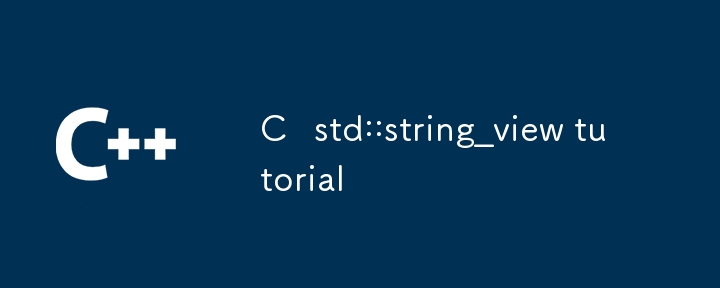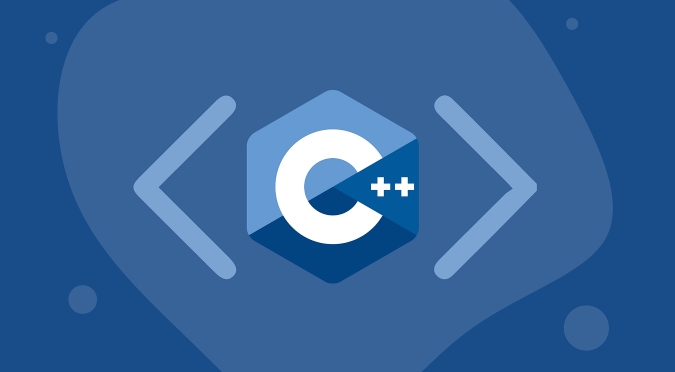std::string_view is a lightweight class in C used to view existing string content, and does not copy or own memory. 1. Replace const std::string& as a function parameter to avoid copying; 2. Support efficient operations such as substr and find; 3. Pay attention to issues such as hanging references, non-modification, and literal length when using them; 4. Applicable to log parsing, performance-sensitive scenarios and general string processing functions.

Using C's std::string_view is actually quite simple. It's just that you "see" the string content without copying it. This is especially useful in handling large numbers of string operations or performance-sensitive scenarios.

What is std::string_view
Simply put, std::string_view is a lightweight string "view" that can point to an existing string (such as const char* or std::string ) but will not own it. You can understand it as a combination of pointer lengths, which makes it very efficient to access.

Common ways to use:
- As a function parameter, instead of
const std::string&to avoid unnecessary copying - Reduce memory allocation when processing string substrings, searching, comparison and other operations
How to use std::string_view to do basic operations
Declare and initialize:

std::string_view sv1 = "hello"; // Point to the literal std::string s = "world"; std::string_view sv2 = s; // Point to the content of string
Common methods:
-
sv.size()gets the length -
sv.empty()determines whether it is empty -
sv.data()gets the underlying character pointer -
sv.substr(pos, len)extracts substring -
sv.find("abc")find content location
For example, extract the domain name part in the URL:
std::string_view url = "https://example.com/path/to/resource";
auto start = url.find("://");
if (start != std::string_view::npos) {
url.remove_prefix(start 3); // Skip the protocol part}
auto slash_pos = url.find('/');
if (slash_pos != std::string_view::npos) {
url = url.substr(0, slash_pos); // Take out the domain name}
// Now url is example.com Notes on using std::string_view
Although it is easy to use, there are some pitfalls to pay attention to:
- Don't save it for too long: because
string_viewis just "looking" on other people's content, and if the original string is released, it becomes a dangling reference. - String literal default length problem: like
std::string_view sv = "hello", it will automatically recognize the length of 5 instead of\0that depends on the end. - Modification problem: You cannot modify the content of
string_viewdirectly, it is read-only (unless you cast it to a non-const pointer, but this is not recommended).
Suggestions for practical application scenarios
- Function parameters are passed : Use
std::string_viewinstead ofconst std::string&to improve efficiency. - Parsing logs, configurations, and text data : can be processed in segments without the need to frequently construct temporary strings.
- Key performance paths : such as network packet parsing and string matching algorithms, memory copy can be significantly reduced.
To give a practical example, write a general string prefix judgment function:
bool starts_with(std::string_view str, std::string_view prefix) {
return str.size() >= prefix.size() &&
str.substr(0, prefix.size()) == prefix;
} Basically that's it. std::string_view is small but practical. The key is to understand that it does not manage memory. Use the right place, the code is simpler and more efficient.
The above is the detailed content of C std::string_view tutorial. For more information, please follow other related articles on the PHP Chinese website!

Hot AI Tools

Undress AI Tool
Undress images for free

Undresser.AI Undress
AI-powered app for creating realistic nude photos

AI Clothes Remover
Online AI tool for removing clothes from photos.

Clothoff.io
AI clothes remover

Video Face Swap
Swap faces in any video effortlessly with our completely free AI face swap tool!

Hot Article

Hot Tools

Notepad++7.3.1
Easy-to-use and free code editor

SublimeText3 Chinese version
Chinese version, very easy to use

Zend Studio 13.0.1
Powerful PHP integrated development environment

Dreamweaver CS6
Visual web development tools

SublimeText3 Mac version
God-level code editing software (SublimeText3)

Hot Topics
 What is high-frequency virtual currency trading? The principles and technical implementation points of high-frequency trading
Jul 23, 2025 pm 11:57 PM
What is high-frequency virtual currency trading? The principles and technical implementation points of high-frequency trading
Jul 23, 2025 pm 11:57 PM
High-frequency trading is one of the most technologically-rich and capital-intensive areas in the virtual currency market. It is a competition about speed, algorithms and cutting-edge technology that ordinary market participants are hard to get involved. Understanding how it works will help us to have a deeper understanding of the complexity and specialization of the current digital asset market. For most people, it is more important to recognize and understand this phenomenon than to try it yourself.
 Explain RAII in C
Jul 22, 2025 am 03:27 AM
Explain RAII in C
Jul 22, 2025 am 03:27 AM
RAII is an important technology used in resource management in C. Its core lies in automatically managing resources through the object life cycle. Its core idea is: resources are acquired at construction time and released at destruction, thereby avoiding leakage problems caused by manual release. For example, when there is no RAII, the file operation requires manually calling fclose. If there is an error in the middle or return in advance, you may forget to close the file; and after using RAII, such as the FileHandle class encapsulates the file operation, the destructor will be automatically called after leaving the scope to release the resource. 1.RAII is used in lock management (such as std::lock_guard), 2. Memory management (such as std::unique_ptr), 3. Database and network connection management, etc.
 Using std::optional in C
Jul 21, 2025 am 01:52 AM
Using std::optional in C
Jul 21, 2025 am 01:52 AM
To determine whether std::optional has a value, you can use the has_value() method or directly judge in the if statement; when returning a result that may be empty, it is recommended to use std::optional to avoid null pointers and exceptions; it should not be abused, and Boolean return values or independent bool variables are more suitable in some scenarios; the initialization methods are diverse, but you need to pay attention to using reset() to clear the value, and pay attention to the life cycle and construction behavior.
 C vector get first element
Jul 25, 2025 am 12:35 AM
C vector get first element
Jul 25, 2025 am 12:35 AM
There are four common methods to obtain the first element of std::vector: 1. Use the front() method to ensure that the vector is not empty, has clear semantics and is recommended for daily use; 2. Use the subscript [0], and it also needs to be judged empty, with the performance comparable to front() but slightly weaker semantics; 3. Use *begin(), which is suitable for generic programming and STL algorithms; 4. Use at(0), without manually null judgment, but low performance, and throw exceptions when crossing the boundary, which is suitable for debugging or exception handling; the best practice is to call empty() first to check whether it is empty, and then use the front() method to obtain the first element to avoid undefined behavior.
 How to develop AI-based text summary with PHP Quick Refining Technology
Jul 25, 2025 pm 05:57 PM
How to develop AI-based text summary with PHP Quick Refining Technology
Jul 25, 2025 pm 05:57 PM
The core of PHP's development of AI text summary is to call external AI service APIs (such as OpenAI, HuggingFace) as a coordinator to realize text preprocessing, API requests, response analysis and result display; 2. The limitation is that the computing performance is weak and the AI ecosystem is weak. The response strategy is to leverage APIs, service decoupling and asynchronous processing; 3. Model selection needs to weigh summary quality, cost, delay, concurrency, data privacy, and abstract models such as GPT or BART/T5 are recommended; 4. Performance optimization includes cache, asynchronous queues, batch processing and nearby area selection. Error processing needs to cover current limit retry, network timeout, key security, input verification and logging to ensure the stable and efficient operation of the system.
 C bit manipulation example
Jul 25, 2025 am 02:33 AM
C bit manipulation example
Jul 25, 2025 am 02:33 AM
Bit operation can efficiently implement the underlying operation of integers, 1. Check whether the i-th bit is 1: Use n&(1
 C std::stringstream example
Jul 20, 2025 am 03:09 AM
C std::stringstream example
Jul 20, 2025 am 03:09 AM
std::stringstream is used in C for string conversion, splitting and splicing strings with basic data types. 1. You can convert the string to int, float, double and other types, use the >> operator to extract the value, and check whether it is successful through ss.fail(); 2. You can process compound strings and extract multiple fields with spaces or separators, which are suitable for parsing CSV files and other scenarios; 3. Support
 C std::is_same example
Jul 24, 2025 am 03:22 AM
C std::is_same example
Jul 24, 2025 am 03:22 AM
std::is_same is used to determine whether the two types are exactly the same at compile time and return a bool value. 1. In the basic usage, std::is_same::value is true when T and U are exactly the same, otherwise it is false. Different modifiers such as const, reference, pointer, etc. will cause false; 2. You can remove the type modification with std::remove_const, std::remove_reference and other types, and then compare it to achieve more flexible type judgment; 3. It is often used in template metaprogramming in practical applications, such as conditional compilation with ifconstexpr, and perform different logic according to different types; 4.






